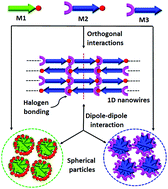Stimuli-responsive luminescent supramolecular assemblies and co-assemblies through orthogonal dipole–dipole interactions and halogen bonding†
Abstract
This article reports π-chromophore assemblies from three structurally related dipolar naphthalene monoimide (NMI) luminogens (M1, M2 and M3) through underexplored orthogonal dipole–dipole interactions and halogen bonding. Single crystal structure analysis together with computational studies emphasized the predominance of dipole–dipole interaction mediated antiparallel π-stacking in the crystalline state, which could be tuned by varying the substituents at the imide- and 4-position of the aromatic ring. Interestingly, the self-assembly in 20% dioxane/methylcyclohexane revealed a different mode of supramolecular interactions. M2, equipped with both a halogen bond (XB) donor (bromine atom) and acceptor (pyridyl group), produced blue emitting 1D nanowires via orthogonal N⋯Br halogen bonding and antiparallel π-stacking. M1 and M3, lacking either the XB donor or acceptor, generated analogous spherical nanoparticles in the absence of extended N⋯Br halogen bonding. However, both M1 and M3 could act as chain stoppers for M2 and regulate its morphology via alternate halogen bonding and π-stacking with M2 in the co-assembled state. By varying the feed ratio between M1 and M2, the co-assembly properties could be tuned. At a lower fraction of M1 (∼1%), nanowires were predominant, while with increasing M1 fraction (>1%), the coexistence of nanowires and spherical particles was noticed. Above 10%, only spherical particles were visualized. Computational studies fully supported the experimental findings and revealed the synchronized operation of multiple noncovalent forces in stabilizing these co-assembled structures under different conditions. Furthermore, the presence of the XB-accepting pyridyl moiety in M1 and M2 rendered the possibility of engineering their supramolecular assemblies and photophysical properties by halogen bonding with an externally added cholesterol-based XB donor (Chol-D). As a result, morphological switching of M1 and M2 occurred in the presence of Chol-D, from green emitting spherical particles to nanotapes and blue emitting nanowires to 2D nanosheets, respectively. The acid-labile pyridyl moiety bestows additional pH-responsive disassembly properties to these luminescent nanostructures.

- This article is part of the themed collection: Journal of Materials Chemistry C Emerging Investigators


 Please wait while we load your content...
Please wait while we load your content...